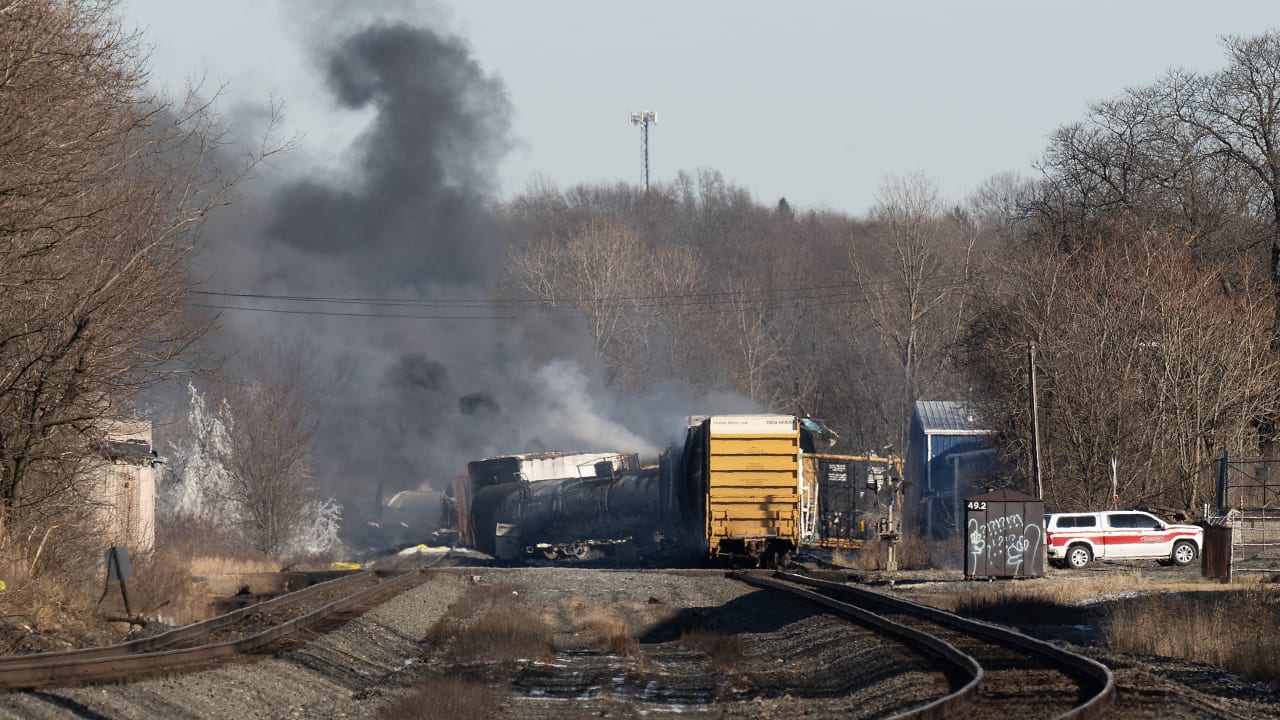Ohio Train Derailment: Toxic Chemical Lingering In Buildings Months Later

Table of Contents
Persistent Contamination: Evidence of Lingering Toxic Chemicals
The Ohio train derailment released a plume of toxic chemicals, including vinyl chloride and butyl acrylate, into the environment. Months later, evidence suggests that contamination persists. Environmental testing, encompassing air quality monitoring, water analysis, and soil sampling, continues to reveal the presence of these harmful substances in various locations around East Palestine.
- Reports of lingering vinyl chloride: Numerous reports indicate detectable levels of vinyl chloride, a known carcinogen, in buildings and soil samples even months after the controlled burn. The persistence of these chemicals raises serious concerns about long-term exposure risks.
- Comprehensive testing methods: Testing has utilized a variety of methods, including gas chromatography-mass spectrometry (GC-MS) to identify and quantify the specific chemicals present. Air quality monitoring involves deploying sensors to measure airborne concentrations of volatile organic compounds (VOCs). Water samples are analyzed for the presence of dissolved chemicals and potential contamination of drinking water sources.
- Specific locations of persistent contamination: Reports point to lingering contamination in residential areas, near the derailment site, and even in some public buildings, highlighting the widespread nature of the pollution. Specific locations are often redacted from public releases due to ongoing investigations.
- Potential long-term health effects: Exposure to vinyl chloride and butyl acrylate is linked to a range of serious health problems, including respiratory issues, liver damage, and an increased risk of cancer. The long-term health consequences for residents remain a significant concern.
Health Concerns: Impact on Residents and First Responders
The lingering presence of toxic chemicals raises serious health concerns for East Palestine residents and first responders. Anecdotal evidence suggests a rise in respiratory problems, headaches, skin irritations, and other health issues since the derailment.
- Reported health issues: Residents have reported a wide range of symptoms, including persistent coughs, difficulty breathing, nausea, and skin rashes, which are potentially linked to exposure to the released chemicals. These reports highlight the need for thorough medical investigations and ongoing monitoring.
- Long-term health risks: The long-term health effects of exposure to vinyl chloride and other toxic substances released in the derailment are not yet fully understood. The potential for delayed onset of serious health problems, including various cancers, is a serious concern requiring comprehensive long-term studies.
- Need for medical monitoring and support: Ongoing medical monitoring and support are crucial for those potentially affected. Access to healthcare and comprehensive health assessments are needed to track potential long-term health impacts and provide necessary treatment. Support for first responders, who were exposed during the initial response, is particularly critical.
- Official health assessments: While some initial health assessments have been conducted, a more comprehensive, long-term study of the health impacts on the community is vital to fully understanding the long-term consequences of the derailment.
Environmental Impact: Long-Term Effects on the Ecosystem
The Ohio train derailment's environmental damage extends beyond the immediate vicinity of the accident site. Soil and water contamination pose significant long-term risks to the ecosystem.
- Extent of environmental damage: The derailment released significant quantities of hazardous substances into the surrounding environment. The contamination extends to waterways, impacting aquatic life and potentially contaminating drinking water sources. Soil contamination can affect plant life and long-term ecosystem health.
- Long-term effects on water supply and soil quality: Water testing continues to reveal the presence of contaminants in local waterways. Soil contamination may persist for years, impacting agricultural land and potentially affecting groundwater supplies. The long-term effects on the quality of drinking water sources remain a major concern.
- Impact on wildlife: The release of toxic chemicals has likely had a significant impact on local wildlife populations, affecting both terrestrial and aquatic species. Long-term monitoring is crucial to assess the extent of the damage and the recovery of the ecosystem.
- Ecosystem recovery timeline: The timeline for the recovery of the affected ecosystem is uncertain and depends on various factors, including the extent of contamination, remediation efforts, and natural processes. The long-term monitoring of affected areas is critical to assessing the effectiveness of remediation efforts.
Government Response and Accountability
The government response to the Ohio train derailment has been under intense scrutiny. Investigations by the Environmental Protection Agency (EPA) and the National Transportation Safety Board (NTSB) are ongoing.
- Government response summary: Initial government responses focused on evacuations, controlled burns, and initial cleanup efforts. However, concerns remain regarding the adequacy of the response and the long-term monitoring of the affected areas.
- EPA and NTSB investigations: The EPA and NTSB are investigating the causes of the derailment and the extent of the contamination. These investigations are crucial to determining accountability and preventing future incidents.
- Regulatory oversight failures: The incident raises serious questions about regulatory oversight and potential failures that contributed to the accident and its devastating consequences. A thorough review of safety regulations and emergency response protocols is essential.
- Legal action: Legal action is likely to be pursued by residents and environmental groups to address the long-term health and environmental consequences of the derailment. This will focus on accountability and potential compensation for affected individuals and communities.
Conclusion
The Ohio train derailment continues to pose significant challenges months after the initial disaster. Lingering toxic chemicals present a serious threat to public health and the environment, highlighting the need for comprehensive remediation efforts and long-term monitoring. The incident underscores the importance of stringent safety regulations and robust emergency response protocols to prevent future catastrophes. The lingering effects of the Ohio train derailment necessitate ongoing vigilance, thorough investigation, and a commitment to environmental justice. Stay informed about the ongoing developments related to the Ohio train derailment and the long-term effects of toxic chemical exposure. Demand accountability and advocate for stronger environmental regulations to prevent similar disasters in the future. Learn more about the ongoing efforts to address the lingering effects of the Ohio train derailment and how you can help.

Featured Posts
-
 Sanctions Contre La Russie Macron Prepare De Nouvelles Actions
May 03, 2025
Sanctions Contre La Russie Macron Prepare De Nouvelles Actions
May 03, 2025 -
 Find The Winning Lotto Numbers Saturday April 12th Draw
May 03, 2025
Find The Winning Lotto Numbers Saturday April 12th Draw
May 03, 2025 -
 The Changing Face Of Christina Aguilera A Fan Perspective
May 03, 2025
The Changing Face Of Christina Aguilera A Fan Perspective
May 03, 2025 -
 Kendal Community Rallies Poppy Atkinson Fundraiser Doubles In A Week
May 03, 2025
Kendal Community Rallies Poppy Atkinson Fundraiser Doubles In A Week
May 03, 2025 -
 The Future Of Doctor Who Davies Suggests A Potential Pause
May 03, 2025
The Future Of Doctor Who Davies Suggests A Potential Pause
May 03, 2025
